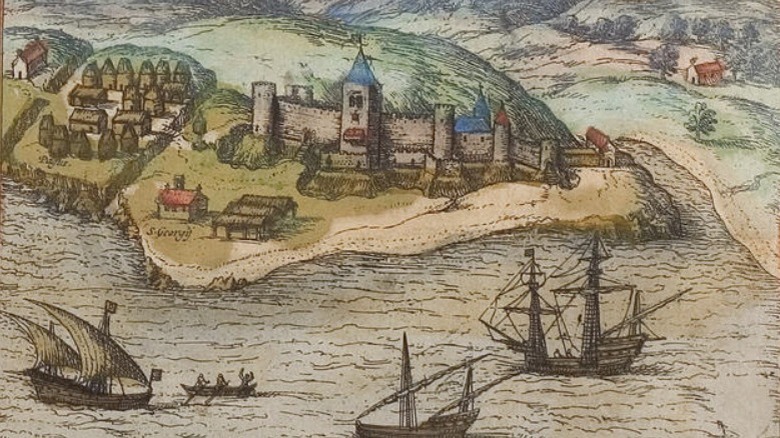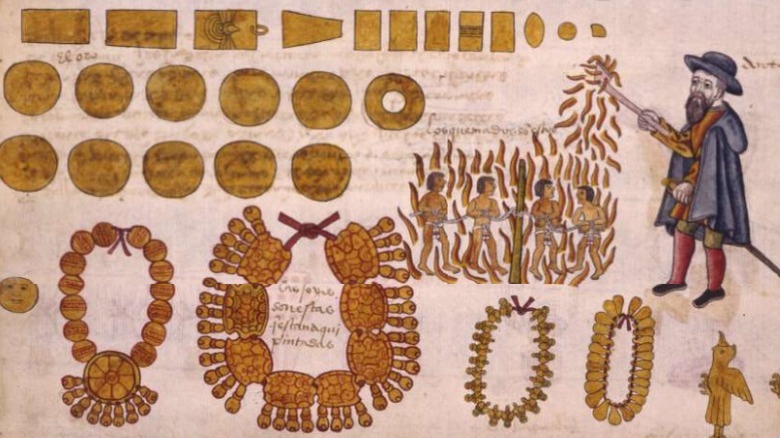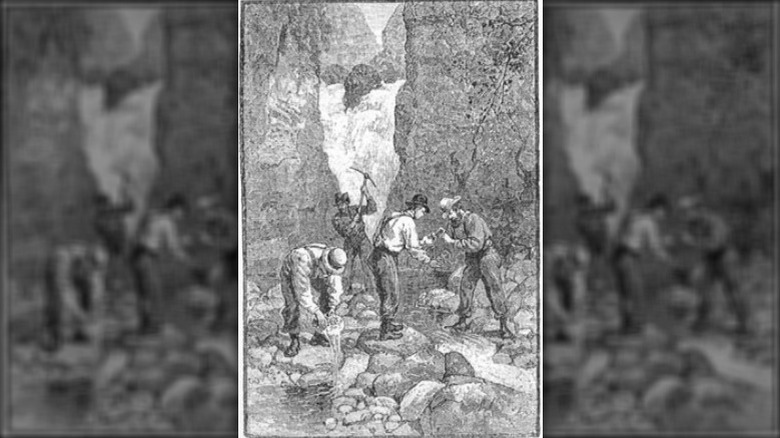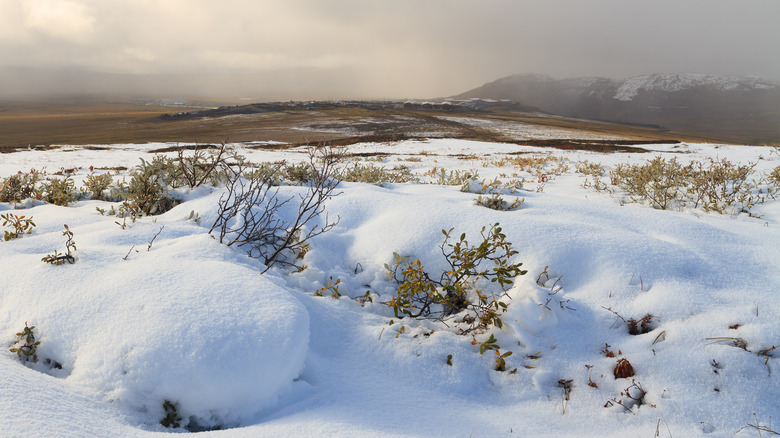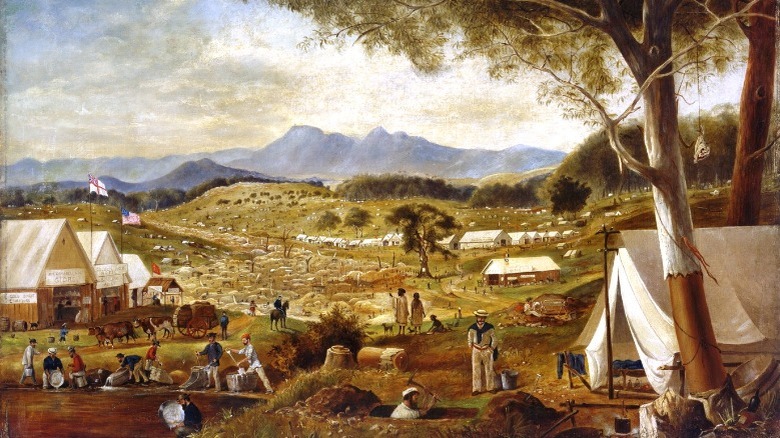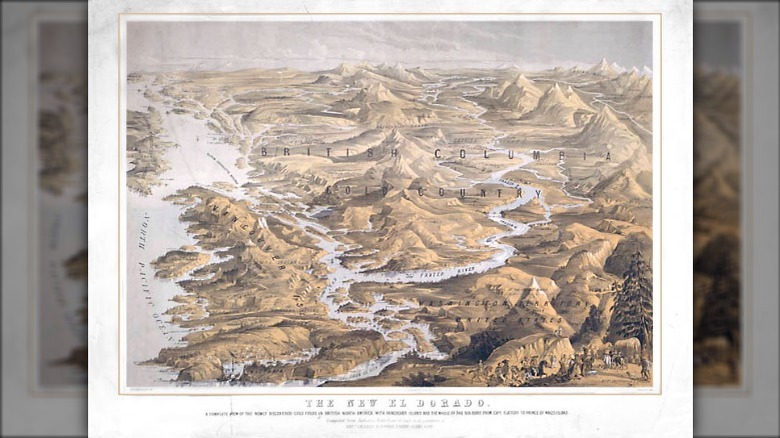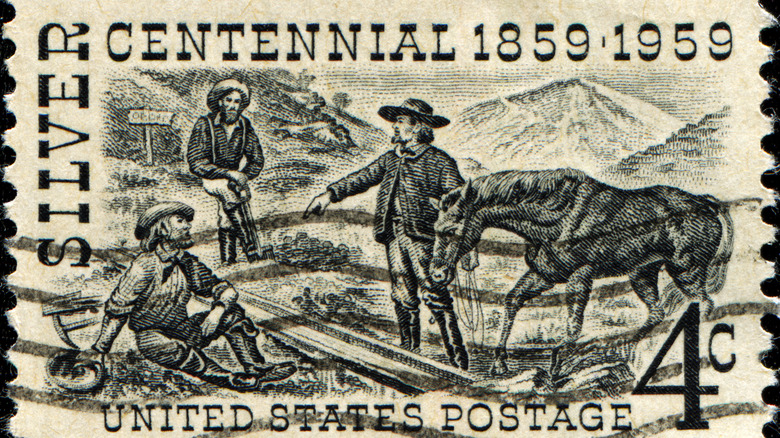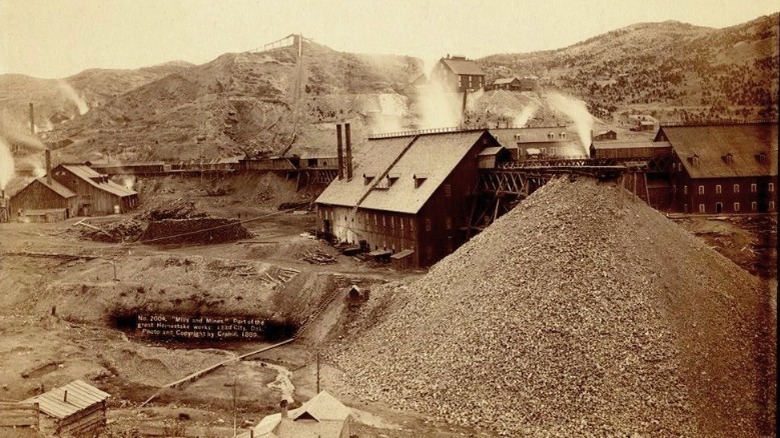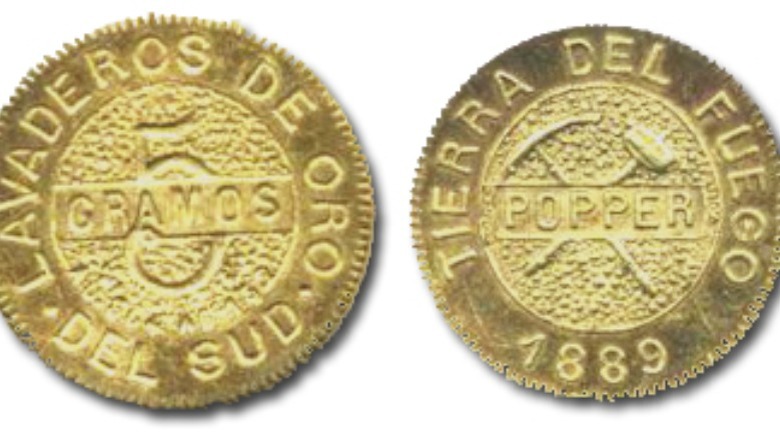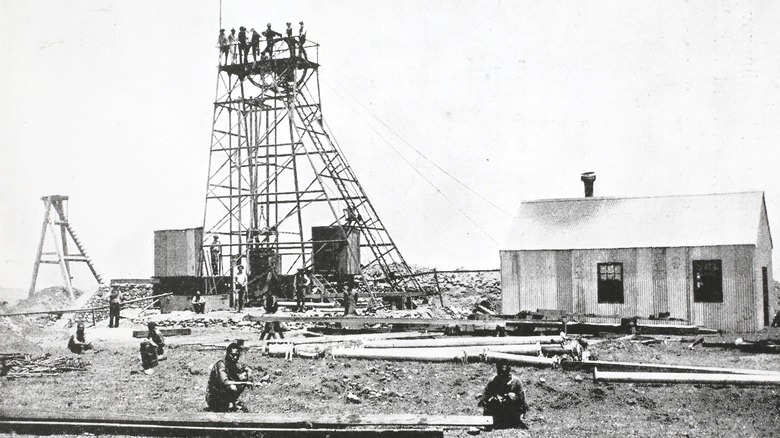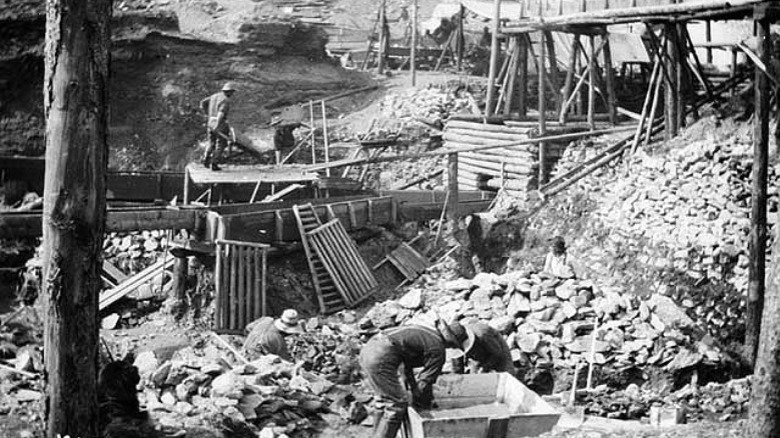Gold Rushes You Didn't Learn About In School
If you grew up in America, chances are the words "gold rush" call to mind the famous California Gold Rush, that 1849 surge of prospectors who descended on the state (technically a territory until 1850) after word got out about the discovery of gold near Sutter's Mill in 1848, per History. Indeed, that may be the only gold rush you think of. As impactful as it was at the time and on Californian and American history thereafter, the California Gold Rush was hardly the only such event of its kind — it wasn't the first, wasn't the last, and, furthermore, America hardly has a monopoly on gold rushes.
Prized since antiquity the world over for its gorgeous color, its relative ease of workability, and its resistance to corrosion and deterioration, gold has long been an object of intense human desire, and thus a source of great potential wealth for those who can acquire a plethora of it. As we'll see, though, one thing almost every gold rush had in common with the others, separated by centuries and continents though many were, was the fact that most participants in the frenzied hunt for the precious metal enjoyed little to no financial gains for their efforts — many were left even worse off than before given all of their expenses for travel, equipment, and provisions, not to mention all the time lost that could otherwise have been spent plying some gainful trade.
Here are some gold rushes you probably didn't learn about in school.
1471: Portuguese explorers descend on Ghana
In what would prove to be very bad news for the local population, in the year 1471, a throng of Portuguese explorers descended on coastal Africa, specifically an area of what is today the Republic of Ghana, per the American Museum of Natural History. What brought these Europeans to distant lands was the discovery of plentiful deposits of gold around the river Pa. Within little more than a decade, the Portuguese had dug in, even constructing stone castles (pictured), in what would come to be called Gold Coast, Ghana's name until 1957, according to Britannica. The Portuguese often used the threat of violence — and occasionally, they turned to outright force — to subdue the native Africans living there, and the Portuguese investment in the region set the stage for centuries of foreign domination.
In later centuries, control of the area shifted from the Portuguese to the Dutch following the defeat of the former by the latter in a war that took place between 1590 and 1609, per Brown. So too would the European exploitation of the region shift from being principally about gold extraction to being about the slave trade, which picked up apace as colonies in what would be America grew. With trade routes already well-established, it made sense that Ghana became a major hub for the exportation of enslaved people.
1500s: Spanish exploitation of the Americas
Arguably the first "gold rush" in the Americas was that of Spaniards hoarding as much gold as they could from Mesoamerican civilizations in the 16th century. As noted, gold had been a prized commodity in ancient cultures in what would later be called Central America, up into Mexico, and down into South America, per the Metropolitan Museum of Art. But in societies like that of the Inca, the Maya, and the Aztec, gold was generally valued for its sacred properties, it was not seen as having an immense value in and of itself. These peoples tended to use gold to craft religious and ceremonial objects, such as figurines or masks of deities, or to make adornments reserved for the most elevated members of society.
When Europeans began to arrive in and exploit the so-called Americas in earnest in the 1500s, gold was of primary interest. The Europeans — primarily Spaniards, at that time — acquired gold from the Americas any way they could, by violence and coercion, by forcing natives to work in mines, by theft, and, occasionally, by trade. Sadly, almost all gold sourced from the Americas by the Spanish, even the most elaborate and finely worked pieces, were melted down into uniform, solid ingots for ease of management and transport. It's impossible to know how many works of esthetic and cultural value were destroyed in those many long years during which Europeans looted gold from the Americas.
1829: The Georgia Gold Rush
The year 1829 saw what can fairly be called the first real gold rush in America, and, similarly to when the Portuguese descended on Ghana in the 15th century, it was an event that spelled disaster for a native population. According to the New Georgia Encyclopedia, that area was Habersham County, Georgia, which is today known as White County. It's not clear exactly when gold was first found in the area, though it was sometime the year before, in 1828, and there are differing accounts of the finds. What's certain, however, is that word got out that there was gold to be found in Northern Georgia, and soon thousands of men rushed to the area, crowding rivers and streams — and beginning to crowd out the Cherokee, the Native Americans who had called the region home for generations.
According to PBS, it was this influx of white prospectors that was largely responsible for the creation of the entirely cruel Indian Removal Act signed by President Jackson on May 28, 1830. With ever more settlers flocking to the region, more land was needed, and this land was simply stolen from the natives, who were forced at the threat of violence (or by its actual use) to vacate their homeland. The forced expulsion of the Cherokee and their migration to new lands hundreds of miles to the west came to be known as the Trail of Tears, per History. Greed for gold was its primary cause.
1838: Siberian Gold Rush
Russia has long been a land for which mineral resources have proved valuable — and, in more recent years, oil and gas resources, as well. The exploitation of these resources has been of particular import in far eastern and northern areas of Russia — Siberia, e.g. — from which minimal other value can be gained, the land largely unfit for farming or commercial production. Thus mining has a long history in Russia. This dates back centuries: major iron and copper mining operations have been in operation east of the Ural Mountains since the late 1600s, per the Library of Congress. But it was not until the year 1838 that notable deposits of gold were found in Siberia, specifically in the basin of the Yenisey River. This find kicked off a Siberian gold rush that would see miners and prospectors come to the area by the thousands over the next few decades.
Unlike with most gold rushes, however, many of those who went in search of gold in Russia did so because they were compelled to, not because they wanted to of their own volition. Among those who worked the mines and panned the rivers in Russia were many migrant workers, mostly Chinese, as well as landless peasants, drifters, and prisoners who were forced to work in abjectly dangerous and miserable conditions. The area around the Yenisey river yielded a fifth of all Russian gold in the middle years of the 1800s.
1851: Australian gold rush
The Australian Gold Rush of 1851 was nearly the same in size and scope as that of the California Gold Rush that came just two years prior to it. According to National Geographic, the Aussie gold rush saw prospectors flocking Down Under from as far and wide as Poland, the U.K., Germany, and even from the United States, including prospectors who departed from California. And, of course, the rush drew in people from all across Australia. It was precipitated by the February find of gold flecks in a body of water near the town of Bathurst, which is in New South Wales, at the southeast of the gigantic country. Over the course of the next year, a staggering half million gold seekers — called "diggers" in the local parlance — came to the area to seek their fortunes.
Few of the diggers would get rich, but what the Australian Gold Rush did serve to do was enrich the Australian sense of identity. According to the National Museum of Australia, the gold rush greatly increased the number of citizens of the country, it created a greater sense of community as the diggers developed camaraderie (or "mateship"), and with the new arrivals and the mobile younger generation of people who had already lived in Australia came new political and cultural ideas and a greater sense of independence from the United Kingdom, though true independence would not come until 1901, per The Oxford University Politics Blog.
1858: Fraser River Gold Rush
The Fraser River Gold Rush that commenced in 1858 was another example of the crush of people afflicted with gold fever causing grievous damage to a native population and shaping the history of a region and a nation. Per The Canadian Encyclopedia, before gold was found in the region known as New Caledonia (part of today's British Columbia) in Canada's far west, the population of the area was a bit below 50,000, and most of the people who lived there were members of indigenous groups. A member of one of these groups, a man from the Shuswap Nation, found gold in the Thompson River in 1856, but the find was kept secret for two years. Word got out when a sample of the Canadian gold was sent to San Francisco for testing in 1857 — the next year, the rush was on.
It was primarily miners and prospectors streaming north from depleted California gold fields who descended on the Fraser Canyon region, with some 50,000 people heading there overall. The influx caused immense friction between gold seekers and natives, and a conflict called the Fraser Canyon War broke out in June of 1858 and lasted three months; it primarily consisted of white men attacking native tribes that were merely defending their homeland. Most miners left the area, destitute, by the mid-1860s, and the newly formed colony of British Columbia — formed in fears newly arrived Americans would try to annex the land — slipped into recession.
1859: The Comstock Lode
Located at an elevation of just over 6,200 feet, the Comstock Lode is a massive deposit of gold and silver found in Storey County, Nevada, per Western Mining History. Or, it was a massive lode of these precious metals in the 19th century, though it has been greatly depleted by years of exploitation. While some "placer gold" — gold that is already separated from ore, per NPS, and can thus be collected through simple techniques like panning or sluicing — had been found in the area in 1849, it was not until the late 1850s that several different finds revealed just how vast the deposits in the area were based on the spacing of the strikes.
Soon, the so-called "Rush to Washoe" was on, Washoe being the name of the county that houses the Comstock Lode. While there was some gold to be found there, it was silver for which the Comstock Lode would become truly famous. Between the years 1860 and 1880, the Comstock Lode yielded more precious metals than all other sites in the country combined, with silver being in by far the greatest abundance. Mining remained in active operation in the area for well over a hundred years, finally ceasing once and for all in the 1980s. The longevity of active mining of the Comstock Lode only added to its importance in U.S. history, with the hundreds of millions of dollars of material it yielded being of perhaps even greater note.
1876: Black Hills Gold Rush
If you have ever seen the Showtime show "Deadwood," then you may already be familiar with how gold was tied to the history of the Black Hills region of South Dakota — or rather, how the region's history was tied to gold. Indeed, Deadwood was a real town, and it was at first a wild, rough-and-tumble place as a gold rush swelled the area with prospectors and the many who catered to their needs, i.e. those who ran or worked in bars and brothels.
Per the U.S. Forest Service, it all started when none other than Colonel George Armstrong Custer led an 1874 expedition to the region that found gold in a waterway called French Creek. The rush was soon on and by 1876, some 10,000 people had settled in the Black Hills. Several towns sprung to life virtually overnight, including Deadwood, soon a town of 5,000, which was large for the place and time — and, unlike what would happen with many boom and bust towns, Deadwood managed to survive and can still be visited today, though today the population is now decidedly smaller at just over 1,150, according to the Census Bureau.
The reason Deadwood became a "real" town instead of a collection of tents and shanties soon abandoned is that, a few years after the gold rush, companies set up larger, steadier mining operations, supplanting individual gold prospectors who panned and sluiced away, and usually in vain.
1883: Tierra del Fuego Gold Rush
One of the strangest gold rushes in history happened because of a freak accident. According to Quasar, in the year 1883, a French steamship named the Arctique accidentally ran aground on the eastern coastline of Tierra del Fuego, one of the most southerly and least hospitable places on earth. A rescue expedition was dispatched to free the ship and save the crew, and in the course of extracting the grounded vessel, the sailors spotted gold in the dark soil where the Arctique had been held fast. Word of the gold find spread fast, and soon gold seekers from all over the world were flocking to the previously almost uninhabited region of Patagonia.
Nearly 4,500 pounds of gold would be extracted from the region in just three short years following that first accidental find, though as is always the case with gold rushes, very few individuals actually got rich as a result of their work. And given the wet, frigid, and often dangerous conditions of the region, it was not a place most prospectors wanted to stay in for long. By 1885 most of the initially discovered gold deposits were fully exploited and most of the gold seekers left. Gold mining did continue in Tierra del Fuego for a number of years, but by 1910, all gold mining operations had ceased in the area, and the gold rush of the 1880s was already a distant memory.
1886: South African Gold Rush
According to South African History Online, in 1884, several gold finds by different men in the region near present-day Johannesburg gave glimmers of what was soon to come, but it was not until two years later that a significant strike was made and a gold rush was on. That strike, made by a man named George Harrison, who found gold on the Langlaagte Farm, was made in July 1886. Just one month later, some 3,000 gold seekers had flocked to the region, hoping to make their fortune by finding gold.
Ironically this gold rush was indeed merited and would lead to copious amounts of gold and, with it, immense wealth — but that was not to be for the individual prospectors and miners who first flocked to the region. By mid-September of 1886, the Witwatersrand Gold Mining Company established the first major mining operation in the region, and within a matter of months, many other companies were setting up there as well.
6Many people had initially assumed that the newly formed town of Johannesburg would not last more than 25 years before depleted gold resources saw everyone leave the region again. Of course, as it happened, the city would only grow, and gold mining continues in the area to this day.
1896: Klondike Gold Rush
When a man named Skookum Jim found gold near the Klondike River near the border of Alaska and Canada's Yukon Territory in 1896, it set off arguably the last great gold rush in history, per the National Park Service. And it was one of the most grueling, disappointing gold rushes of them all for most of the astonishing 100,000 prospectors who headed to the remote, frigid region not far below the Arctic Circle. There were many routes miners could take to reach the Klondike, and all of them involved long boat trips — by sea and river — followed by many miles tramping on foot, usually hauling heavy gear and often repeating the same journey back and forth from a place of disembarkation to the potential gold fields.
Death was seldom far away for the gold seekers, what with the wretched weather, occasional avalanches, disease, malnutrition, and murders. Though miners continued to head to the Klondike up until the year 1899, that year, other gold strikes and a lack of success in the Klondike area brought the last great gold rush to a sudden end.
Modern California gold seekers
There is another California Gold Rush of sorts happening today, per Smithsonian Magazine. In any given year, some 50,000 people still head out to the rivers and streams of the Golden State in search of the precious metal. Most contemporary prospectors are hobbyists, not people truly seeking their fortune, and many of their number are older and retired, but still, all hope to find a nugget or two large enough to be of true value, and some are indeed trying to earn a supplemental income.
Today's prospectors use much the same approach as the '49ers did more than 170 years ago, panning away at river dirt or running it down through sluice boxes in hopes of seeing that unmistakable golden shimmer. And as the price per ounce of gold is often well above $1,600 these days, via AMPEX, it's no surprise why the allure for it remains so strong.

